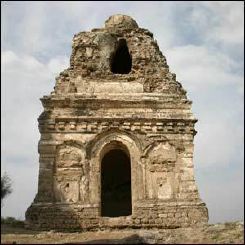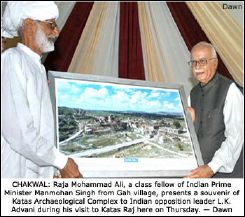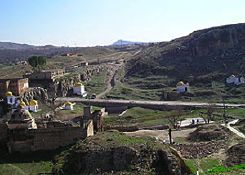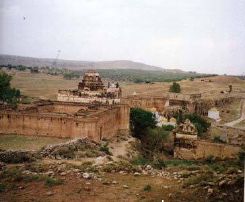 In October-November 2006, more than 200 Hindu pilgrims (yatrees) came from outside of Pakistan to visit Katas Raj.
In October-November 2006, more than 200 Hindu pilgrims (yatrees) came from outside of Pakistan to visit Katas Raj.
The mention of Katas Raj, located in the salt range 18 miles south of Chakwal, is found in Maha Bharat written in 300 BC. The etymology of this place as narrated in the old edition of Tarikh-i-Jhelum (History of Jhelum) is that according to Brahaman belief, Shiv Devta wept so profusely on the death of his beloved wife Satti that two holy ponds – one at Pushkar of Ajmair and other at Katak Shell – came into being with his tears. In Sanskrit, the word – Katak Shell – means chain of tears which later on was pronounced as ‘Katas’.
Leader of Opposition in Lok Sabha and President Bharatiya Janata Party (BJP) L.K Advani  also visited Katas Raj to inaugurate the conservation work at Satghrah temple in June this year. The photo to the right is from that occasion.
also visited Katas Raj to inaugurate the conservation work at Satghrah temple in June this year. The photo to the right is from that occasion.
According to Gen Cunningham, Katas was considered the second largest holy place in Punjab for Hindu pilgrims after Jawala Mukhi. It is said famous Pando brothers spent 12 years in Katas and built the temples of Satghara. It is said Al-Beruni also spent some time at Katas to learn Sanskrit in a linguistic university which, at that time, was established here. Temples at Katas have been transferred from the federal government to the Punjab Archaeology Department recently.


Katas Raj is also the place where Alberuni attempted to measure the circumference of the Earth, studied Sanskrit and wrote his renowned Kitab-ul-Hind (Book of Hind) which depicted the religion, scientific knowledge, and social customs of Hindus. Paras Nath Jogi drew his last breath on Katas. Jagat Guru Nanak Ji also visited the place on the 1st of Visakh. Katas came to be known as Nanaknawas and was a site of contemplation for many large groups of mystics, ascetics and jogis. According to Hindu beliefs, taking bath in the holy pond at the site washes away all sins and makes man innocent.


















































Ah yes, that place is beautiful. I went there two years ago and sadly it lay in ruins, pun unintended. I hope they have changed that now by preserving it better.
Haha. Poor Cowasjee. Though I must admire the creativity of the guy who pasted these names up. Kamal Jacqui/Camel Jockey? Too good!
Hey Eidee Man, did you email Cowasjee about it. He should know people do read with some attention and do not take his every word as engraved in stone.
Thank you, once again, for a very informative post. Learnt a lot here. Glad to hear that conservation work is being done there. Do you have any information on how that work has gone or is going?
Shirazi Sb
Thanks for the informative article. I wonder what role the motorway M2 has played in bringing Ketas Raj to the forefront. I must admit that while growing up I was not aware of Ketas Raj existense. All the limelight was put on Potohar/Salt range area around the GT road. The most I’d heard of Potohar area’s heritage was about Rohtas Fort. It is in the past 10 or less years that Motorway has really opened up the Kallar-Kahar and Chakwal area to tourism. One regularly hears about Ketas Raj temples and pilgrimage to them in the media now. I hope and wish that this heritage is well taken care of by the govt of Pakistan.
Hi, this is not about this particular post so I apologize. But I’d like to turn everyone’s attention to Cowasjee’s latest column:
http://dawn.com/weekly/cowas/cowas.htm
He wrote:
“Since 1979, there have of course been other Muslims â€